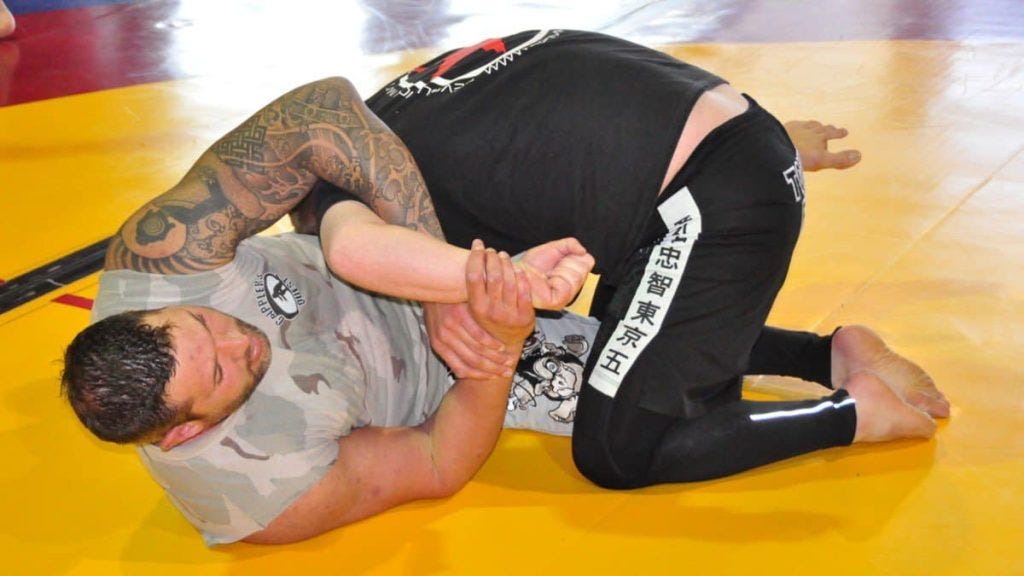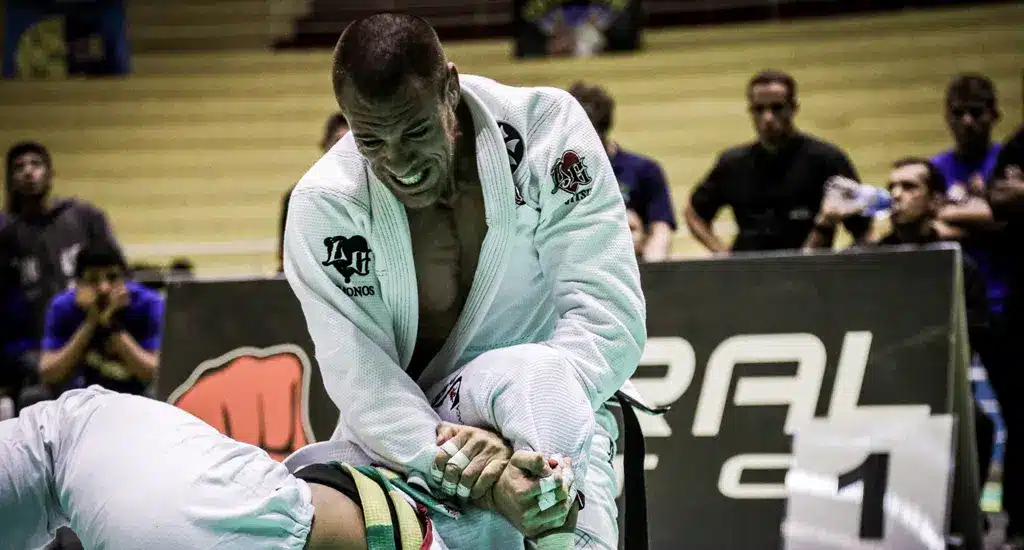Table of Contents
Introduction to the Kimura in Brazilian Jiu Jitsu
Brazilian Jiu Jitsu (BJJ) is celebrated for its intricate techniques and strategic maneuvers that enable practitioners to defeat opponents of diverse sizes and strengths. Among these techniques, the Kimura stands out as a versatile and highly effective submission move. The Kimura targets the shoulder joint, allowing grapplers to control and submit their opponents through leverage rather than sheer strength. Whether you are a beginner or an experienced grappler, mastering the Kimura can significantly enhance your BJJ repertoire by providing multiple avenues for offense and defense during a match.
The Kimura’s origins trace back to the legendary judoka Masahiko Kimura, who famously defeated Helio Gracie in a historic grappling match using the gyaku ude-garami, the arm lock that now bears his name within the Jiu Jitsu community. This pivotal moment not only cemented the Kimura’s place in BJJ but also showcased its effectiveness in real combat scenarios. Today, the Kimura is a fundamental technique taught in BJJ schools worldwide, celebrated for its adaptability in both gi and no-gi settings. Understanding its historical significance and technical execution is essential for any practitioner looking to excel in the martial art.

Understanding the Kimura Technique in Brazilian Jiu Jitsu
A double-lock armbar targeting the shoulder joint, the Kimura is a highly effective submission move in both gi and no-gi Brazilian Jiu Jitsu (BJJ). This versatile technique enables practitioners to control their opponents by isolating an arm and applying rotational pressure, utilizing biomechanics to force a tap-out. Celebrated for inducing significant discomfort and potential injury, this submission compels adversaries to concede during a match. Its effectiveness spans various grappling scenarios—from executing guard passes to facilitating smooth transitions—making it a crucial addition to any BJJ practitioner’s submission arsenal.
In contrast to single-lock armbars that primarily hyperextend the elbow or wrist, the Kimura provides multiple pathways for control and submission by manipulating the shoulder from diverse angles. This adaptability allows grapplers to adjust the technique based on their opponent’s reactions and positioning, creating opportunities to transition into other dominant holds or escape unfavorable situations. The ability to apply pressure from various directions not only enhances its effectiveness but also serves as a strategic tool for maintaining control and directing the flow of the match. Mastery of this submission thus equips fighters with a multifaceted technique that boosts both offensive and defensive capabilities on the mats.
Basic Mechanics of Executing the Kimura
Executing this shoulder lock begins with isolating your opponent’s arm, a crucial first step in setting up the submission. Secure a figure-four grip around the arm, where one hand controls the wrist while the other grasps the bicep or wrist. This grip establishes a strong leverage point, enabling effective manipulation of the limb. The objective is to force the shoulder to bend unnaturally, increasing pressure on the joint and making it challenging for the opponent to escape. Proper isolation and grip are essential for maintaining control and ensuring the technique is applied smoothly and efficiently.
Once the figure-four grip is in place, apply rotational pressure to the shoulder joint. This movement not only heightens the opponent’s discomfort but also opens opportunities to transition into other dominant positions if the initial submission attempt is resisted. By maintaining a stable base and controlling the opponent’s body, you can adjust the angle and force of the lock to maximize its effectiveness. Mastery of these basic mechanics allows practitioners to execute the technique with precision, making it a reliable and versatile move in both offensive and defensive scenarios on the mat.

The Origin of the Kimura: Etymology
The name “Kimura” honors Masahiko Kimura, a legendary Japanese judoka renowned for his exceptional skill and innovative techniques in martial arts. In judo, this shoulder lock is known as gyaku ude-garami, translating to “reverse arm entanglement,” which reflects its complex and intricate nature. Kimura’s mastery of this technique demonstrated his ability to control and submit opponents through precise manipulation of their limbs. His contributions not only showcased the effectiveness of gyaku ude-garami but also laid the foundation for its integration into other grappling disciplines, including Brazilian Jiu Jitsu (BJJ).
Within the rich history of Brazilian Jiu Jitsu, the Kimura gained immense popularity following a pivotal match between Masahiko Kimura and Helio Gracie, one of BJJ’s founders. During this legendary grappling contest, Kimura successfully defeated Gracie by applying the gyaku ude-garami lock, highlighting its effectiveness even against highly skilled opponents. This decisive victory not only cemented Kimura’s legacy but also deeply ingrained the technique into the BJJ curriculum. Consequently, the Kimura became a revered and widely practiced submission hold within the BJJ community, symbolizing both technical prowess and strategic advantage on the mats.
The Kimura’s Strategic Importance in Brazilian Jiu Jitsu
A cornerstone technique in Brazilian Jiu Jitsu (BJJ), the Kimura is highly valued for its versatility and control. One of its primary strategic purposes is serving as a reliable submission opportunity; this arm lock can lead directly to a tap-out, making it an effective tool in both gi and no-gi settings. Additionally, it functions as a powerful control mechanism, allowing practitioners to dominate their opponents by restricting their movements and dictating the pace and flow of the match. This level of control is essential for maintaining advantageous positions and setting up further attacks or defenses.
Beyond serving as a submission and control tool, the Kimura provides significant positional advantages. Successfully applying this lock can transition practitioners into dominant positions such as side control or back control, which are crucial for maintaining superiority in a grappling exchange. These transitions not only enhance overall grappling strategy but also increase the likelihood of securing victory by continuously putting the opponent on the defensive. The ability to offer multiple avenues for attack and control makes this submission an indispensable tool in a BJJ practitioner’s arsenal, contributing to both offensive and defensive strategies on the mat.

Advantages of Using the Kimura in Brazilian Jiu Jitsu
One of the primary benefits of this shoulder lock is its versatility. It can be effectively applied from various positions, including guard, mount, and side control, making it adaptable to different phases of a match. Whether initiating an attack from the bottom or maintaining control from the top, the Kimura provides multiple entry points for both offensive and defensive maneuvers. This adaptability ensures that practitioners can utilize the technique in a wide range of scenarios, enhancing their overall grappling strategy and allowing for seamless transitions between positions.
Another significant advantage lies in the leverage it offers over sheer strength. Unlike techniques that rely on brute force, the Kimura leverages biomechanics to apply pressure efficiently, making it effective even against larger and stronger opponents. This leverage-based approach minimizes the risk of injury while maximizing control and submission potential. Additionally, the Kimura has substantial setup potential, as it can be used to initiate other submissions or sweeps. By establishing a figure-four grip, practitioners can create opportunities to transition into more dominant positions or chain into additional submission holds, making this arm lock a multifaceted tool in any BJJ practitioner’s arsenal.
Comparative Analysis of the Kimura in Brazilian Jiu Jitsu
When compared to other arm locks, such as the Americana, this shoulder submission offers distinct advantages in terms of control and flexibility. While the Americana primarily targets the shoulder joint through a single-lock mechanism, the Kimura engages the entire arm, providing superior control over the limb. This comprehensive control allows practitioners to manipulate the arm from various angles, enhancing the effectiveness of the submission. Additionally, its adaptability means it can be applied from multiple positions, including guard, mount, and side control, making it a more versatile technique within a grappler’s arsenal. This increased flexibility allows for more varied applications and adjustments based on the opponent’s movements and defenses.
Furthermore, the Kimura excels in creating seamless transition opportunities, linking effortlessly into other positions and submissions. This fluidity provides practitioners with numerous strategic options during a match, enabling them to maintain momentum and capitalize on their opponent’s reactions. For instance, a successful Kimura can transition into dominant positions such as side control or back control, or set up additional submissions like the triangle choke or omoplata. This interconnectedness not only enhances the practitioner’s offensive capabilities but also improves their overall grappling strategy by offering multiple pathways to victory. The ability to facilitate smooth transitions makes this technique highly strategic and valuable in both competitive and training environments.
Influential Athletes Who Master the Kimura
Several Brazilian Jiu Jitsu (BJJ) and Mixed Martial Arts (MMA) practitioners have showcased the effectiveness of the Kimura in high-stakes competitions. Rickson Gracie, renowned for his technical mastery, has utilized this shoulder lock to dominate opponents in both gi and no-gi settings, demonstrating its versatility and control. Demian Maia, a prominent MMA fighter, has frequently employed the Kimura in his grappling arsenal, securing multiple victories through precise and strategic application of the technique. Gordon Ryan, a top-ranked BJJ competitor, exemplifies the lock’s continued relevance and adaptability, using it effectively in tournaments to outmaneuver and submit elite opponents. These athletes have not only mastered the Kimura but also elevated its status within the grappling community.
Their successful implementations of this submission have had a significant impact on both BJJ and MMA, inspiring practitioners to refine their own techniques. Rickson Gracie’s legendary matches set a high standard for technical excellence, while Demian Maia’s MMA career highlights the lock’s practicality in real combat scenarios. Gordon Ryan’s innovative approaches in competitions demonstrate the technique’s evolution and strategic depth. By consistently applying the Kimura in various contexts, these athletes have proven its effectiveness and versatility, encouraging a new generation of grapplers to incorporate the submission into their training regimens. Their achievements underscore the lock’s role as a fundamental and powerful tool in the arsenal of any serious Jiu Jitsu practitioner.
Competition Highlights Featuring the Kimura
One memorable instance of this arm lock’s effectiveness occurred during the historic match between Masahiko Kimura and Helio Gracie. In this legendary grappling contest, Kimura applied the gyaku ude-garami (reverse arm entanglement) to secure his victory against Gracie, one of the founders of Brazilian Jiu Jitsu (BJJ). This decisive use of the submission showcased its superior leverage and technical precision, overpowering a highly skilled opponent. The match not only highlighted Kimura’s mastery of the technique but also demonstrated the lock’s potential to influence the outcome of high-level grappling competitions, solidifying its place in martial arts history.
The impact of this iconic match reverberated throughout the BJJ community, establishing the Kimura as a fundamental and reliable submission technique. Practitioners worldwide were inspired to incorporate the arm lock into their training and competition strategies, recognizing its versatility and effectiveness. Over the years, this technique has continued to play a pivotal role in numerous high-stakes matches, both in BJJ and Mixed Martial Arts (MMA), proving its adaptability and enduring relevance. The legacy of the Kimura in the Kimura vs. Gracie match underscores its importance in the evolution of grappling arts and its continued prominence in modern competitive scenarios.
The Kimura’s Place in Modern Brazilian Jiu Jitsu
In today’s Brazilian Jiu Jitsu (BJJ) landscape, the Kimura remains a staple technique, continually evolving alongside the sport’s advancements. Modern practitioners incorporate this submission into various systems, adapting it to suit both gi and no-gi environments. This adaptability ensures that the technique remains relevant across different grappling contexts, whether utilizing the traditional gi grips or relying on body positioning and grip variations in no-gi settings. Additionally, the submission is seamlessly integrated with other contemporary techniques, enhancing its effectiveness and allowing practitioners to create more dynamic and unpredictable strategies during matches.
Integrating this arm lock with other techniques has greatly enhanced its utility in modern Brazilian Jiu Jitsu. Practitioners often use it to transition into dominant positions like side control or back control, or to chain into submissions such as the triangle choke or omoplata. This adaptability improves both offensive and defensive maneuvers by providing multiple escape options. Additionally, advancements in training methods and a better understanding of biomechanics have led to innovative variations, ensuring its continued effectiveness in competitive and training settings. As the sport evolves, this submission remains a fundamental and versatile tool for practitioners looking to excel in the dynamic landscape of Brazilian Jiu Jitsu.
Integration of the Kimura with Other Techniques in Brazilian Jiu Jitsu
The adaptability of the Kimura makes it an invaluable tool that seamlessly integrates with a wide range of moves and strategies in Brazilian Jiu Jitsu (BJJ). One notable application is guard passing, where transitioning from a Kimura to a guard pass can provide significant control advantages. By securing a figure-four grip while attempting to pass the guard, practitioners can manipulate their opponent’s posture and limit their mobility, making it easier to advance to more dominant positions. This strategic linkage not only enhances the effectiveness of guard passing but also ensures that the practitioner maintains control throughout the transition, minimizing the risk of counterattacks.
Beyond guard passing, the Kimura is instrumental in executing sweeps and reversals, allowing practitioners to shift the momentum of a match in their favor. By leveraging the submission to off-balance an opponent, grapplers can initiate sweeps that reverse the position, granting them superior positioning and control. Additionally, this arm lock can be incorporated into submission chains, where it serves as a foundational hold that links to other submissions such as the triangle choke or omoplata. This ability to form cohesive and formidable submission sequences not only increases the practitioner’s offensive capabilities but also enhances their overall grappling strategy, making the Kimura a cornerstone technique in both offensive and defensive maneuvers on the mat.
Future Outlook of the Kimura in Brazilian Jiu Jitsu
As Brazilian Jiu Jitsu (BJJ) continues to expand its global footprint, the Kimura is set to remain a fundamental and highly regarded technique within the sport. Its enduring relevance is attributed to its versatility and effectiveness across various levels of competition and practitioner skill sets. The submission’s ability to adapt to both gi and no-gi environments ensures that it remains applicable in diverse grappling scenarios. Additionally, the increasing popularity of BJJ in mixed martial arts (MMA) further solidifies the Kimura’s status as a crucial submission technique, as fighters seek to incorporate its leverage and control into their overall combat strategies.
Innovations in training methods and a deeper understanding of biomechanics are likely to drive the evolution of this shoulder lock, leading to new variations and applications that enhance its effectiveness. Advances in sports science and technology enable practitioners to refine their technique with greater precision, optimizing leverage and minimizing the risk of injury. Furthermore, the integration of analytical tools such as video analysis and biomechanical feedback allows for a more comprehensive study of the submission’s mechanics, fostering the development of advanced techniques and strategic implementations. As BJJ evolves, the Kimura will continue to be a cornerstone technique, supported by ongoing research and innovation that ensure its adaptability and prominence in the ever-changing landscape of grappling arts.
Conclusion: The Kimura’s Legacy in Brazilian Jiu Jitsu
The Kimura is more than just a submission hold; it embodies the rich history and strategic depth of Brazilian Jiu Jitsu (BJJ). Originating from the legendary match between Masahiko Kimura and Helio Gracie, this arm lock has evolved into a versatile and indispensable technique within BJJ. This evolution highlights the submission’s ability to adapt and remain relevant across different eras and competitive landscapes. Its enduring presence in training and competition underscores its significance as a foundational move that every practitioner should master.
Its ability to offer exceptional control, facilitate effective submissions, and seamlessly integrate with other techniques makes this shoulder lock a valuable tool for practitioners at all levels. By mastering the Kimura, grapplers can significantly enhance their technical proficiency and strategic prowess on the mats. Whether used as a standalone submission or as part of a larger grappling strategy, this technique provides multiple avenues for offense and defense, ensuring that practitioners can maintain an advantage in various combat scenarios. Embracing the Kimura not only improves individual skill sets but also contributes to the overall advancement and sophistication of Brazilian Jiu Jitsu.
References and Further Reading
Books
- Jiu Jitsu University by Saulo Ribeiro
- Mastering Jujitsu by Renzo Gracie and John Danaher
Articles
- “The History of the Kimura Lock in BJJ” – BJJ Hero
- “Advanced Techniques: The Kimura” – GracieMag
Videos
- Tutorials:
- Kimura Technique Tutorial by BJJ Fanatics
- Historic Match:
- Masahiko Kimura vs. Helio Gracie
Appendices (Optional)
Glossary of Terms
- Gi: The traditional uniform worn in Brazilian Jiu Jitsu.
- No-Gi: A style of BJJ practiced without the traditional uniform, usually using rash guards and shorts.
- Submission: A technique that compels an opponent to concede defeat, often through joint locks or chokeholds.
FAQs
Can the Kimura be applied from any position?
While the Kimura is versatile and can be initiated from various positions, it is most commonly applied from the guard, side control, and mount.
Is the Kimura safe to practice for beginners?
Yes, when performed with proper technique and under supervision, the Kimura is safe. It’s essential to tap early if experiencing discomfort to prevent injury.
How does the Kimura differ in gi and no-gi training?
In gi training, grips on the uniform can provide additional leverage and control, while in no-gi, practitioners rely more on body positioning and grip variations.
How useful was this post?
Click on a star to rate it!
Average rating 5 / 5. Vote count: 2
No votes so far! Be the first to rate this post.
Author
-

Meet Anthony Ernst, a Jiu Jitsu Purple Belt. Anthony is a multi-talented entrepreneur who wears many hats. As the owner of ThreeSphere Websites, he combines his expertise in web development with his artistic vision to craft stunning and functional websites for clients. With a love of the Martial Arts he brings an interesting perspective to Combatch.Live Articles.
View all posts
